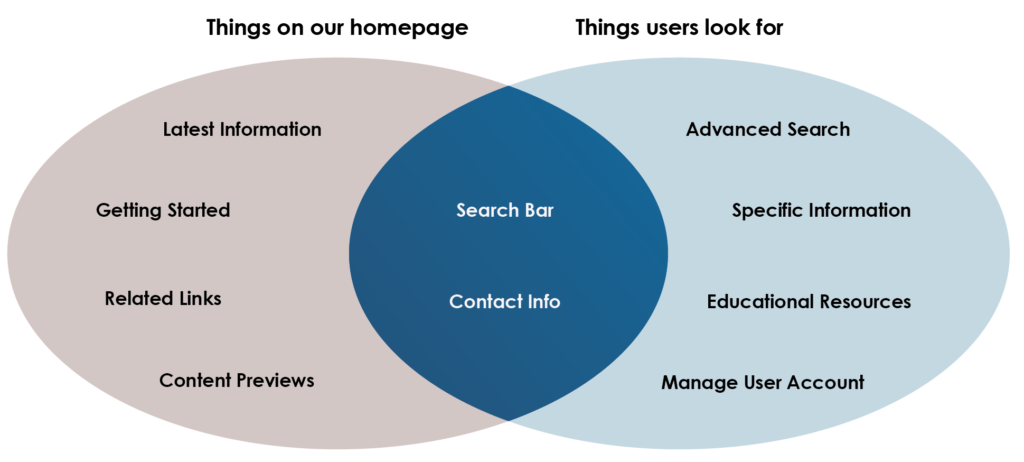Drive Design Decisions from User Input
The UX design process entails providing an experience for users to interact with an organization’s digital product (e.g., a website, software or web/mobile application). UX design comes into play whenever there is an interaction or touchpoint with the product. UX design includes everything that occurs prior to, during and post development. The goal is to not only address users’ needs but to also anticipate what they want or desire, creating a seamless digital experience. It is important to keep the design more user-focused and not organization-centric. Users need to dictate the design as opposed to what your organization or agency believes is vital to communicate. From start to finish, the user’s perspective should be a priority. Users should be asked why they come to your website or use your software instead of pushing information that is viewed as necessary for them to consume. The chart below illustrates the difference between what users actually seek on a website and what they instead find there.

Equally important is to provide the right combination of usability and functionality. In other words, the product needs to be easy to use, while simultaneously addressing the operations that need to be performed. Working to obtain the right balance of use and function initially and then continually improving upon them in an iterative fashion is the primary purpose of UX design.
User experience goes beyond usability and functionality to include the visual and emotional aspects felt for the product. This means that it is not only about how well a user can navigate and utilize the product, but also what kind of impression it leaves behind and what type of feeling they get from using it. In the end, the level of satisfaction that users receive in interacting with a product will determine the success of the UX design.
Accessibility is another very important facet of UX design. Accessibility guidelines help ensure that your digital product is easy to use and inclusive, regardless of ability, for everyone. According to the CDC, approximately one-quarter (26%) or 61 million adults in the U.S. live with a disability. The UX design process, therefore, should consider and provide inclusive design practices that adhere to the Web Content Accessibility Guidelines (WCAG) 2.2 for users with a wide range of disabilities. The mindset for being accessible is considering those with permanent disabilities, including auditory, cognitive, neurological, physical, speech and vision, as well as those with intermittent and temporary disabilities, such as someone with a broken arm, light sensitivity, poor vision due to eye surgery, or poor hearing from being in a loud room. Inclusive design begins with the understanding that design should accommodate what the minority needs in addition to what the majority of people require to benefit all individuals. Accessibility and user-driven design go hand-in-hand; you can’t provide a good experience for all users, without being aware of their different needs and abilities.
CHECKLIST
- Discuss the various interactions users have with your digital product
- Address the digital product interface (visual, interactive and accessible) that need to be considered to provide a positive overall experience to all users
- Consider branding in terms of consistency, clarity, coherent messaging and eye-pleasing touchpoints
- Establish the specifics within each stage of the UX design process—types of user research (e.g., survey, in-depth interviews, observations), types of analysis (e.g., personas, user flows), types of design (wireframes, mockups, prototypes) and types of evaluation (e.g., user testing and quantitative and qualitative methods)
- Create understanding with clients and stakeholders that product design should be user-centered
KEY QUESTIONS
- What are most important aspects of the design process to the primary decision makers?
- Do we have any lessons learned (including both successes and failures) from previous iterations of this product or similar products?
- What techniques and tools should be determined in advance?
- What types of communication needs to be scheduled with UX design team, clients and stakeholders?
- Which accessibility guidelines should be addressed from the inception and product ideation stage?
